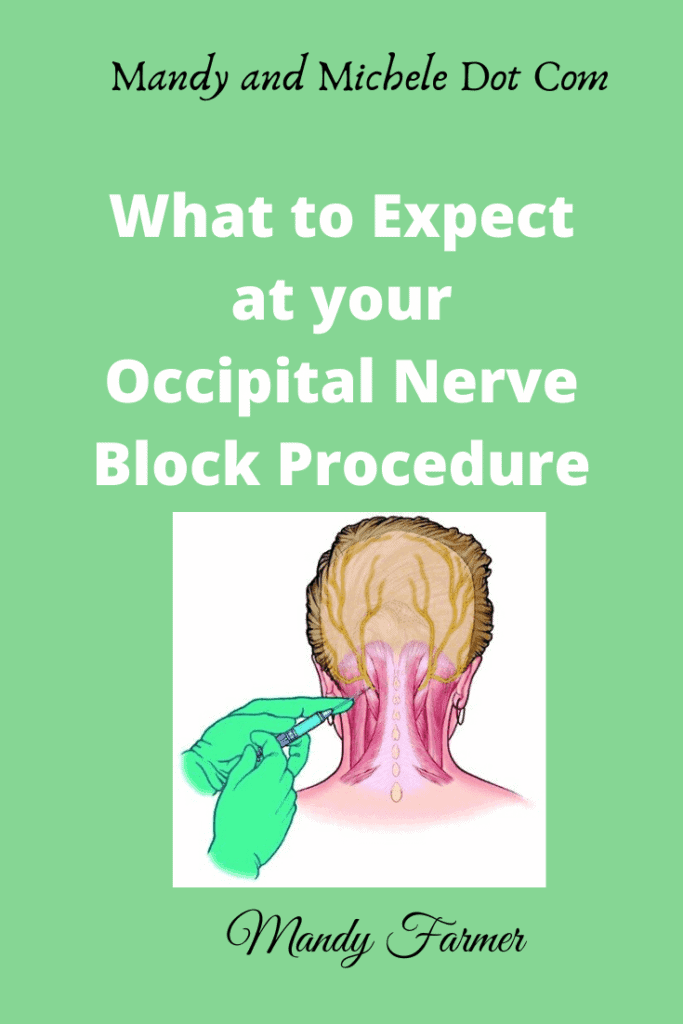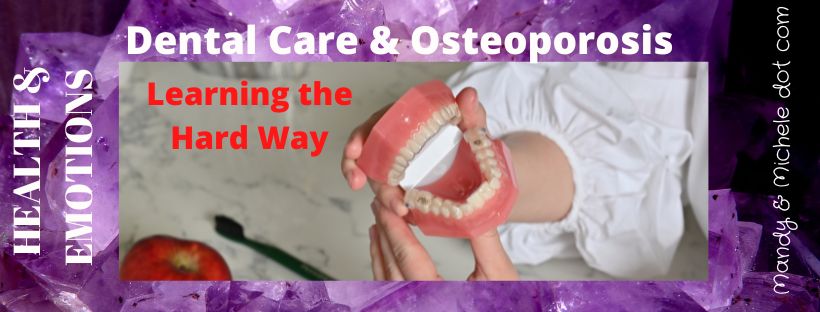I recently had an Occipital Nerve Block done. It can be a bit scary to think about having a long needle stuck into your neck going upward toward your brain. I have had about a dozen of these and they are so helpful for me. So… I thought maybe I should explain what it is and share my experience.
Why Do I Get Occipital Nerve Blocks?
I have rheumatoid arthritis (also known as R.A.). One day I will write more about that but just a quick explanation. R.A. attacks the small joints, such as your hands and fingers, feet, and toes. But it also goes after the C1-C2 joint in your neck. Mine is deteriorating which is causing pain from the base of my head radiating upward to the top of my head. These nerve blocks have worked exceptionally for me. I get one every 6-9 months.
What is an Occipital Nerve Block?

An occipital nerve block is a safe procedure that may be performed in a doctor’s office or pain clinic. The occipital nerve block technique is relatively quick and convenient, and is done with minimal invasion (i.e. intrusion into tissues with medical equipment). For the procedure, you’ll be seated or lying down. The injection itself only takes a few minutes, and is done without full sedation.
During the procedure:
- A local anesthetic may be applied to your skin above the occipital nerve to be targeted in order to avoid discomfort during the procedure.
- Then, a fine needle (like a hypodermic) is inserted, until it is in an appropriate position near the nerve.
- Next, steroid medications are injected. These drugs reduce inflammation and block the transmission of pain signals to the brain, thus inhibiting the sensation of headache pain.
If an occipital nerve block has been successful, you may feel that the side of your head that has been injected has gone numb. Your physician or pain specialist may request that you stay in the clinic or office for a brief period, during which the actual degree of your pain relief may become apparent. The time elapsed before you experience pain relief does vary from person to person; it may be nearly instantaneous for one individual, but take a day or more for another.
An occipital nerve block does not often interfere with normal function or routines following a procedure. The patient may not notice the full effect of the intervention until a few days after the procedure. This may last a month or more, at which point the patient may arrange for a repeat injection. However, some patients may require two injections in quick succession to elicit an optimal effect.
The above is from The Pain Doctor Website.
https://paindoctor.com/treatments/occipital-nerve-block/
My Experience Getting a Nerve Block
I am so fortunate to have Mayo Clinic as part of my medical team. This place is amazing. After about 2 years of diagnosis and care for my Central Sensitivity Syndrome and R.A., it was discovered that my C1-C2 disks were already deteriorating. I was experiencing quite a bit of pain in my head, neck, and shoulders. SoI was sent to the Pain Clinic.
One of the biggest advantages of Mayo Clinic is everything under the same roof. The doctors all work together on your health. No matter which doctor you see, they can pull up all my records and see what the other doctors are doing and thinking.
So back to the topic at hand…
This procedure is done right in the office. Mayo Clinic just remodeled this part of the clinic and the clinic now has a beautiful procedure area. First, the nurse will sit down with you and talk to you about the side effects and wound care. She will ask the level of pain you are experiencing at the moment.

Then you just “pull up” to a gurnie with a pillow and lay your head down. (If you have long hair, bring a scuncii to pull your hair up our of the way.) The injection is going in right at your hair line.
The doctor arrives by this time and he and the assistant set up the ultrasound and find the greater occipital nerve. They find precisely where they want that needle to go. Then the injection area is cleaned and prepped.
Just a quick plug for my doctor.
Dr. Mark Hurdle is amazing. So understanding and compassionate and very personable. When my daughter was getting married, I asked if we could go ahead and schedule my next injection just before the wedding so that I could (hopefully) be pain-free that day. It was no problem. We scheduled the procedure that day. And as hoped the injection did its thing and I was pain-free for the wedding. My appointment following the wedding, he came in asking how the wedding went. I share that to show that he is involved in his patients’ lives.
On the professional side, Dr. Hurdle is THE expert on this procedure. He goes all over the world teaching doctors how to do this procedure. That fact alone makes me very calm about the injection.
And now the injection
An anesthetic injection is given. I noticed above that it says “A local anesthetic may be applied to your skin”. NOTE: I would ask about this because I actually get an injection for numbing. I’ve had others say that this procedure was VERY painful. Some even said they had the doctor stop. This must be why my experience has not been terribly painful.
We wait for the numbing to take over (just a couple of minutes) and then the procedure begins. It’s a long needle (so my husband says) and it is worked in along the occipital nerve using the ultrasound. Then he begins to inject the medicine. At times, I can feel the burn of it entering but it really isn’t that bad for me. Not any worse than going to the dentist.
To divert my attention, I recite scripture in my head or sing a song. Before long, it’s all done. And immediately I have lots of pain relief. I sit up and they let me wait to get my senses back. You can feel kind of woozy for a bit, but I have some balance issues anyway.
I let my hair back down and we are done. The worst effects are goo in your hair and a bandaid in your hairline that can be a challenge to get out the next day. You can take a shower that night, but don’t get in a jacuzzi or soak in a tub.
Follow-up
They sent me home with a page of instructions for wound care and things to watch for. This most recent injection, I woke the following morning with a flushed face. I shot off a message to the clinic and got an immediate response that this is normal and not to worry.
Two weeks later, I received a call or message to ask how my pain is doing. I recall one time that my pain had returned to some extent and again they called immediately with questions and instructions.
My recommendation
I totally recommend this procedure if you experience severe migraines or head and neck pain. Just be sure to find a doctor who knows what they are doing. We drive the 2 hours to Jacksonville, FL to have this done though I am certain there are doctors here in Savannah that would do it. It’s a long day trip but worth the drive. Plan to take the next day off to rest.
I’ve had this done about a dozen times. (every 6-9 months) This is a procedure that can be done indefinitely until it doesn’t work. And the alternatives (neck fusion surgery taking a good year to recover) are not desirable.
Feeling your pain!

P.S. Read here for fluoroscopic-guided…
Fluoroscopic-Guided Occipital Nerve Block

Pastor’s Wife (retired) & Chronic Pain Warrior blogs about how to make it through anything by relating her own life experiences to her writing. She is passionate about her love for the Lord and desires to spread that passion to others. She has a great desire to encourage women who are following behind her.





Dear Mandy,
Thanks for sharing the good info! And I am so thankful that this is continuing to work for you! Mine worked at first, but then began to be less and less effective, which is why we just went through the nerve ablation process. I am still waiting to see the final results of this. Isn’t it amazing what they are able to do nowadays? Sometimes I feel like I am on a Sci-Fi episode when they begin talking about new treatments! May God continue to bless you and help you on your journey, dear friend.
Yes, Bettie, I am always amazed at what they can do these days. Thanks for your support. You remain in my prayers.
A fantastic overview of what this is & what to expect, Mandy. I’m glad this option is available, and I hope it can continue to be of benefit for you and others. My dad has RA but his is predominantly knees, followed by hands and elsewhere. Good tip on the anaesthetic before it’s done – I would want to ask for that too!
Caz xx
thank you, Caz! I know it doesn’t work for everyone but it has been a lifesaver for me! Thanks for coming by.